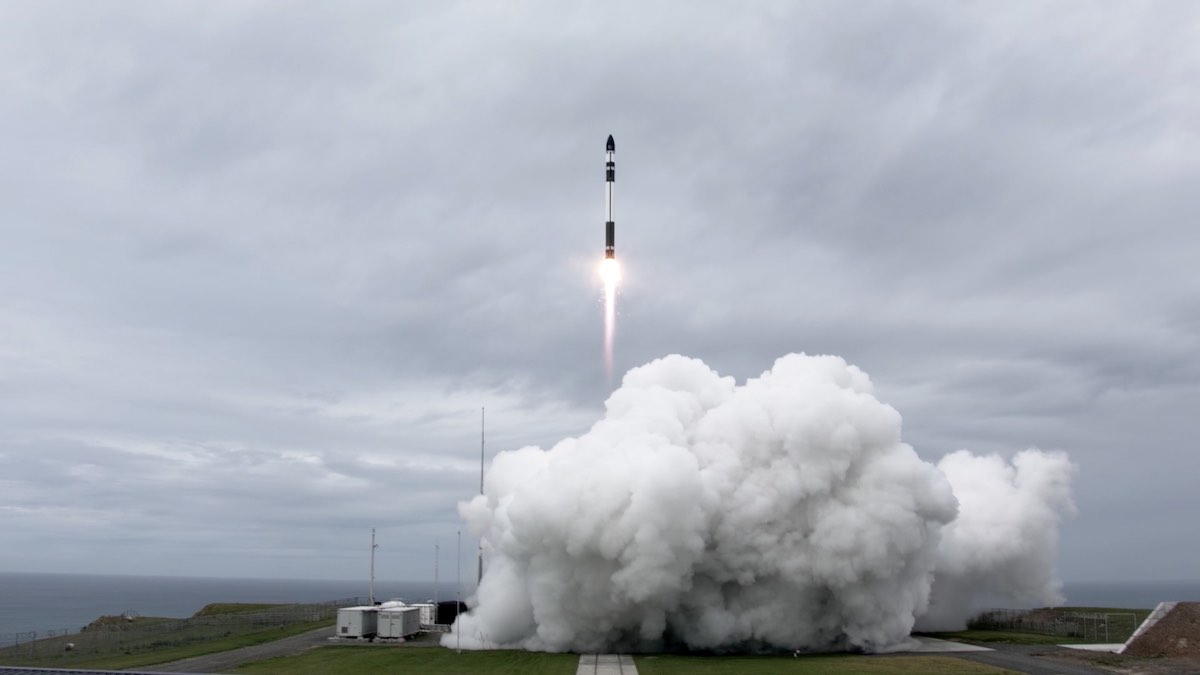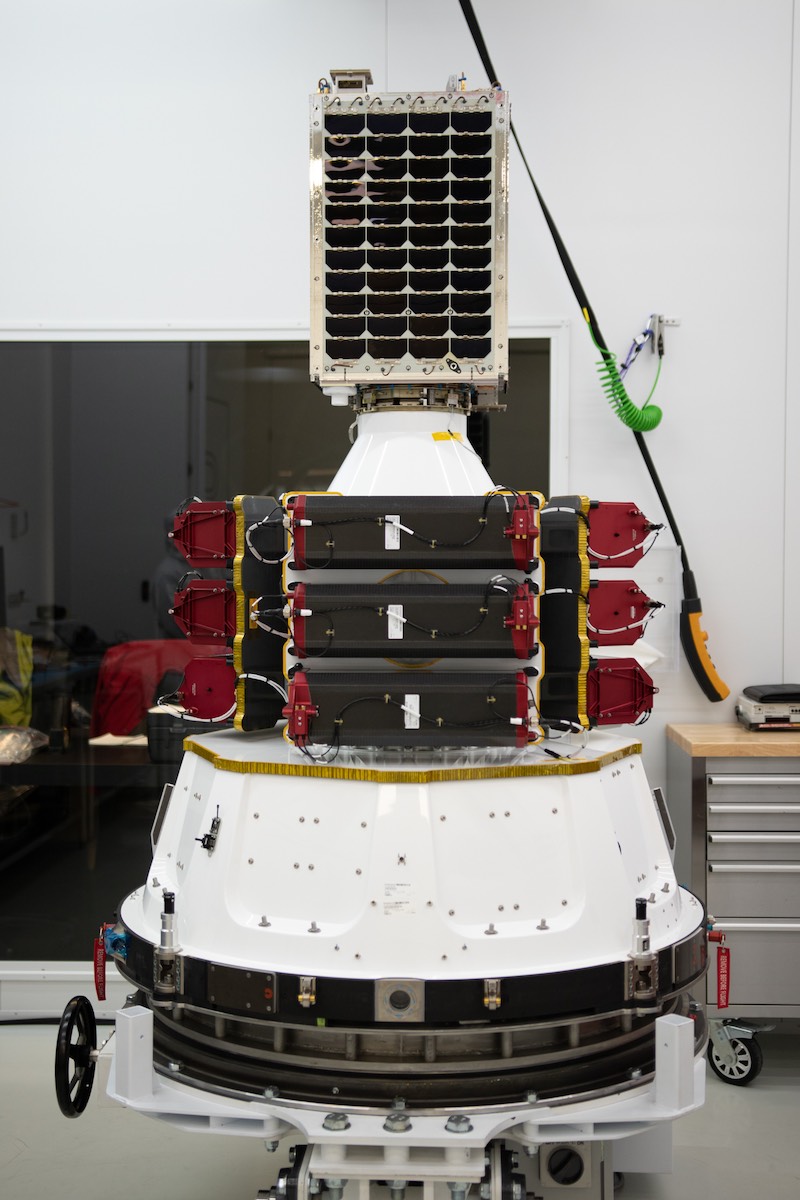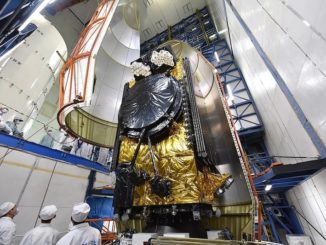
An experimental satellite for Canon Electronics and nine Earth-imaging CubeSats for Planet fired into orbit from New Zealand on Wednesday on top of a Rocket Lab Electron booster, taking the place of similar spacecraft destroyed in a Rocket Lab launch failure in July.
Nine Rutherford main engines roared to life and sent the nearly 60-foot-tall (18-meter) Electron rocket into an overcast sky at 5:21:27 p.m. EDT (2121:27 GMT) Wednesday. A live webcast from Rocket Lab showed the all-black carbon-fiber launcher climbing away from the company’s privately-operated spaceport on the North Island of New Zealand.
Liftoff occurred at 10:21 a.m. local time Thursday in New Zealand.
Producing more than 50,000 pounds of thrust, the nine kerosene-fueled main engines powered the Electron rocket through a gray layer of clouds. Flying toward the south over the Pacific Ocean, the Electron’s first stage shut down and jettisoned around two-and-a-half minutes after liftoff, and a single engine ignited to continue the mission into Earth orbit.
Moments later, the aerodynamic shroud covering the rocket’s 10 satellite payloads jettisoned. The rocket released a spent battery pack nearly seven minutes into the mission, as the second stage’s engine swapped to a fresh battery to power its turbopumps.
Nine minutes after liftoff, the second stage engine shut down and deployed Rocket Lab’s kick stage. After sailing over Antarctica, the kick stage’s Curie engine fired for about two minutes to reach a circular orbit roughly 310 miles (500 kilometers) in altitude, with an inclination of 97.5 degrees to the equator.
The 10 small satellites riding on the kick stage separated into an on-target orbit about one hour into the mission, according to Rocket Lab.
Rocket Lab nicknamed the mission “In Focus” in honor of the 10 Earth observation satellites on-board the Electron launcher. The California-based company delayed the launch from Oct. 21 to evaluate a concern with an oxygen sensor.

“Congratulations to Planet on the addition of their latest SuperDoves to their constellation and to the team at Canon Electronics on the deployment of their latest tech demonstration satellite,” said Peter Beck, Rocket Lab’s founder and CEO. “Electron has once again delivered a smooth ride to orbit and precise deployment for our individual rideshare customers.
The mission Wednesday marked Rocket Lab’s 15th launch of an Electron booster, and the company’s fifth mission of 2020.
“Continuing to launch in the face of global disruption and adversity, while at the same time becoming the second-most frequently flown U.S. launch vehicle this year, is the latest display of our dedication in providing ongoing, easy access to space for our customers,” Beck said.
The largest spacecraft on Wednesday’s mission was CE-SAT-2B, an Earth observation satellite for Canon Electronics of Japan.
The 78-pound (35.5-kilogram) spacecraft is Canon’s third microsatellite to launch, following an experimental Earth-imaging station that launched in 2017 on an Indian PSLV rocket.
A follow-on satellite named CE-SAT 1B launched in July on a previous Rocket Lab mission, but it was destroyed when the Electron rocket failed before reaching orbit.
According to Canon, CE-SAT-2B carries three types of cameras to be demonstrated in orbit.
“With the newly developed super high sensitivity camera, CE-SAT-2B is capable of observing the Earth during night time,” Canon said in a press release. “The satellite is equipped with three types of cameras including Canon’s mirrorless camera and compact digital camera.
“CE-SAT-2B will go through a two-year demonstration experiment for forthcoming production of cassegrain reflectors as series,” Canon said.
Spaceflight, a Seattle-based launch broker, arranged for the launch of CE-SAT-2B with Rocket Lab.
Nine SuperDove Earth-imaging satellites — each about the size of a large shoebox — ejected from Maxwell deployers on the Electron rocket’s kick stage. The SuperDove payloads, built and owned by Planet, will replace five similar satellites — collectively known as “Flock 4e”– that were also lost on Rocket Lab’s failed mission in July.
“Emerging from the unfortunate launch accident of Flock 4e on Electron in July, this next launch speaks to both Planet and Rocket Lab’s resilience and agility to get back on the pad so quickly,” Planet wrote in a blog post on its website. “These SuperDoves will be deployed into an approximate 500 km (310-mile-high) morning-crossing sun synchronous orbit (SSO), joining the rest of the flock already providing unprecedented medium-resolution global coverage and revisit.”
Email the author.
Follow Stephen Clark on Twitter: @StephenClark1.



